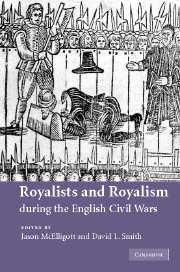Book contents
- Frontmatter
- Contents
- Notes on contributors
- Preface
- Abbreviations
- 1 Introduction: rethinking royalists and royalism
- 2 A lesson in loyalty: Charles I and the Short Parliament
- 3 The Court and the emergence of a royalist party
- 4 Varieties of royalism
- 5 Royalist reputations: the Cavalier ideal and the reality
- 6 Counsel and cabal in the king's party, 1642–1646
- 7 ‘I doe desire to be rightly vnderstood’: rhetorical strategies in the letters of Charles I
- 8 Royalists and the New Model Army in 1647: circumstance, principle and compromise
- 9 The royalist origins of the separation of powers
- 10 ‘A No-King, or a New’. Royalists and the succession, 1648–1649
- 11 The royalism of Andrew Marvell
- Subject Index
- Author Index
4 - Varieties of royalism
Published online by Cambridge University Press: 19 July 2009
- Frontmatter
- Contents
- Notes on contributors
- Preface
- Abbreviations
- 1 Introduction: rethinking royalists and royalism
- 2 A lesson in loyalty: Charles I and the Short Parliament
- 3 The Court and the emergence of a royalist party
- 4 Varieties of royalism
- 5 Royalist reputations: the Cavalier ideal and the reality
- 6 Counsel and cabal in the king's party, 1642–1646
- 7 ‘I doe desire to be rightly vnderstood’: rhetorical strategies in the letters of Charles I
- 8 Royalists and the New Model Army in 1647: circumstance, principle and compromise
- 9 The royalist origins of the separation of powers
- 10 ‘A No-King, or a New’. Royalists and the succession, 1648–1649
- 11 The royalism of Andrew Marvell
- Subject Index
- Author Index
Summary
A study of royalism necessarily entails a discussion not only of why some people unhesitatingly followed King Charles but also of what impelled erstwhile royalists to abandon the cause and others, who had once been parliamentarian or ‘neuter’, to become supporters of the House of Stuart. It requires attention to the ‘middle’, probably a majority of the population, who initially put peace and quiet above principle and hoped to evade choice between sides, and to some of the factors that nevertheless ultimately led many to become partisan, albeit often reluctantly. This chapter will look at some of the varieties of royalism that constituted its rainbow coalition, a coalition that included men and women of strikingly diverse personalities whose allegiance derived from a variety of considerations. It will also argue that convergences of opinion between many royalists and parliamentarians formed a common past and, together with links based on shared interest and social and economic connection, survived and helped to ameliorate the strains imposed by the killing, destruction, expropriation, violent polemic and disillusion of the Civil War. These convergences contributed to the survival of a society and constitution that retained enough of the elements familiar in the past to make the new states, both of commonwealth and Restoration, recognizably continuous with the old.
- Type
- Chapter
- Information
- Royalists and Royalism during the English Civil Wars , pp. 66 - 88Publisher: Cambridge University PressPrint publication year: 2007
- 3
- Cited by



